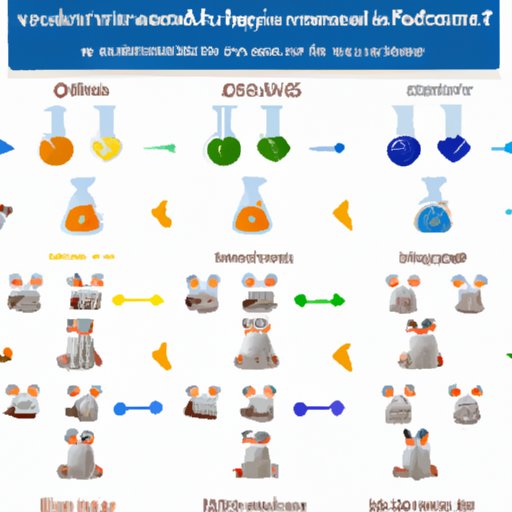
Introduction
Converting grams to moles is an essential concept in chemistry that enables scientists to understand the chemical composition of substances. Understanding how to convert grams to moles helps to calculate the mass of atoms, the number of molecules in a substance, and the chemical reactions that occur within a substance. This article aims to explain how to convert grams to moles, why it’s important to know this concept, and how to use different approaches to grasp and learn it.
The “Mathematical” Approach
The gram-to-mole formula is a simple mathematical conversion that involves dividing the mass (in grams) of a substance by its molar mass (in grams per mole). The formula is as follows:
Moles = Grams ÷ Molar Mass
To use this formula, follow these steps:
- Determine the mass of the substance in grams.
- Find the molar mass of the substance in grams per mole.
- Divide the mass of the substance by its molar mass.
For example, if you want to convert 10 grams of water to moles:
- The mass of water is 10 grams.
- The molar mass of water is 18 grams per mole (1 mole of water contains 6.02 x 10^23 molecules, and each molecule has two hydrogen atoms with a mass of 1 gram per mole and one oxygen atom with a mass of 16 grams per mole).
- Divide 10 grams of water by 18 grams per mole, yielding approximately 0.556 moles of water.
The “Real-World” Approach
Grams to moles conversion is a crucial concept in various fields, including chemistry, cooking, and pharmacology. For instance, in cooking, measuring ingredients in grams and converting them to moles helps chefs create precise recipes for their dishes. In pharmacology, converting drug measurements from grams to moles helps pharmacists understand the potency of a medication and the correct dosage to give to patients.
Real-world examples that showcase the importance of grams to moles conversion are:
- Determining the number of atoms and molecules in a substance.
- Calculating the amount of reactant or product in a chemical reaction.
- Measuring drug concentrations in pharmacology.
- Calculating the mass of food ingredients in cooking recipes.
- Determining the molecular weight of a compound in chemistry.
The “Visual” Approach
Visual aids play a crucial role in understanding complex concepts such as grams to moles conversion. Infographics, diagrams, or flowcharts can help to simplify the conversion process, making it easier to grasp. Visuals aid in presenting the material more engagingly, which makes concepts stick in a learner’s mind more easily.
Examples of visuals that can be used to enhance grammatical understanding are:
- Flowcharts that show the step-by-step procedures for converting grams to moles.
- Demonstration diagrams that show how to calculate molar mass of a substance.
- Animated videos that explain the concepts behind grams to moles conversion.
The “Interactive” Approach
Interactive tools such as online calculators or quizzes help to make the conversion process more engaging and fun. An online calculator that converts grams to moles allows users to input the substance’s mass and the molar mass, and then calculates the substance’s moles. Interactive quizzes, on the other hand, test how well learners can convert grams to moles by providing questions and immediate feedback on the answers provided.
Examples of interactive tools that are useful in learning include:
- Conversion calculators such as Wolfram Alpha or Convertunits.com.
- Online quizzes on sites such as Quizlet and Khan Academy
- Mobile apps like ChemCrafter and Molarity.
The “Example-Based” Approach
Using examples is a popular approach to teaching concepts such as grams to moles conversion. Examples help learners understand the concept’s practical applications by showing how to convert grams to moles in different scenarios. For instance, in cooking, examples of converting grams to moles include measuring out ingredients like salt, sugar, and flour. In chemistry, examples include calculating the amount of reactant or product present in a chemical reaction.
Examples offer the following advantages:
- They demonstrate the practical applications of converting grams to moles, making the concept more relatable.
- They make it easier to understand complex concepts in a familiar context.
- They engage learners in problem-solving activities, which help in consolidating the knowledge acquired.
The “Problem-Solving” Approach
Providing problem sets to solve is an effective approach to grasping the core concepts of converting grams to moles. Problem-solving activities encourage learners to cement their knowledge by applying the concept to real-life scenarios. Additionally, problem-solving activities develop critical-thinking skills and enhance problem-solving abilities.
Example problems for converting grams to moles include:
- What is the number of moles of sugar in 10 grams of sugar?
- What is the mass of a substance containing 3.5 moles of oxygen atoms?
- If you have 25 grams of copper (II) hydroxide, what quantity, in moles, of copper (II) hydroxide do you have?
Conclusion
Converting grams to moles is an essential concept in chemistry and other fields. Understanding the conversion process enables scientists, chefs, pharmacists, and other professionals to measure ingredients precisely, calculate the amount of reactant or product in chemical reactions, measure drug concentrations, and determine the molecular weight of a compound. Using different approaches, such as the mathematical, real-world, visual, interactive, example-based, and problem-solving approaches, learners can grasp the concept and develop their skills in converting grams to moles.
Tips for remembering the conversion process include determining the mass of the substance in grams, finding the molar mass of the substance in grams per mole, and dividing the mass of the substance by its molar mass. In conclusion, understanding the conversion of grams to moles is essential for learners in various fields and provides insights into the composition of substances.





